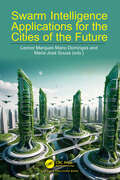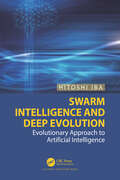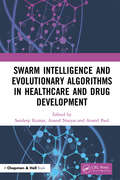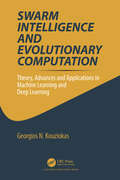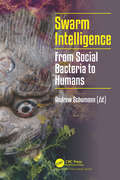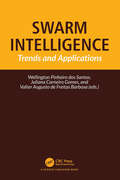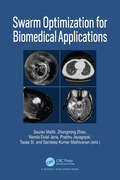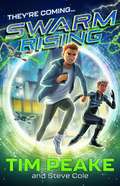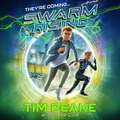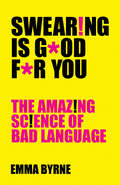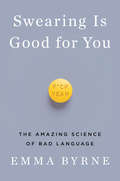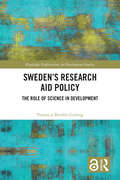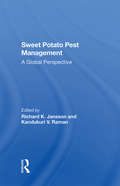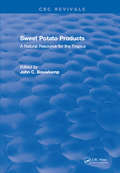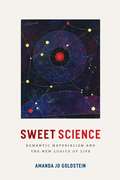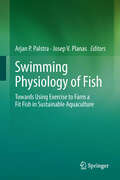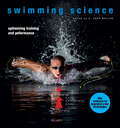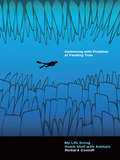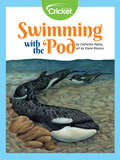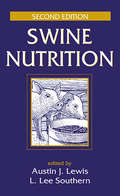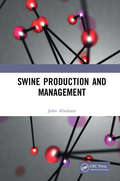- Table View
- List View
Swarm Enemy: Book 2 (Swarm Rising #2)
by Steve Cole Tim PeakePerfect for fans of Alex Rider, Young Bond and Cherub, this fast-paced action-adventure is the second thrilling story from astronaut Tim Peake and bestselling author Steve Cole. The alien Swarm is rising once more... When Danny's best friend Jamila goes missing, and no one remembers she exists, Danny knows the alien Swarm are back on Earth. They've tracked the digital energy signals Jamila has been unintentionally transmitting. Her alien-enhanced DNA can be used to clone super-strong beings with super-powers, and now it's not just the Swarm who are after her. Danny needs to find Jamila - and a new version of Adi, the friendly Swarm scout - and together they must stop both humans and aliens from destroying the human race.'Hi-powered, hi-concept and hi-jinks. Swarm Rising has it all!' Eoin Colfer, author of Artemis Fowl, on Swarm Rising
Swarm Intelligence Applications for the Cities of the Future
by Maria José Sousa Leonor Marques Mano DomingosThis book explores the transformative power of swarm intelligence and digital innovations in shaping the cities of the future. It presents a comprehensive analysis of how social learning, citizen engagement, advanced technology, design, construction, planning and public policies converge to create cities that are sustainable, resilient, and inclusive.The initial chapters stress the importance of collective intelligence in urban development, using technologies like Virtual Reality to increase citizen participation and democratise decision-making. Public policies play a key role in driving the digital transformation needed for greener cities, with frameworks and tools to enhance transparency and accountability. Digital technologies in policymaking ensure that policies are adaptive, data-driven, and responsive to real-time challenges. Internet of Things systems are explored for their role in improving public safety, urban resilience, and energy efficiency through digital twins, blockchain, and sensor networks. Swarm intelligence is highlighted for optimising energy management, reducing consumption, and promoting renewable resources. Healthcare integration into urban planning and sustainability is also discussed, with a comparative analysis of cities showing how tech innovation enhances resilience against climate change. Swarm intelligence beyond cities is also explored, such as for disaster response, healthcare, environmental conservation, and agriculture. Autonomous systems like drones and nanobots are shown to improve efficiency across various sectors.Overall, this book advocates for a holistic approach to urban development, integrating digital technologies and collective intelligence to create cities that are technologically advanced, socially equitable, and environmentally sustainable.
Swarm Intelligence and Deep Evolution: Evolutionary Approach to Artificial Intelligence
by Hitoshi IbaThe book provides theoretical and practical knowledge about swarm intelligence and evolutionary computation. It describes the emerging trends in deep learning that involve the integration of swarm intelligence and evolutionary computation with deep learning, i.e., deep neuroevolution and deep swarms. The study reviews the research on network structures and hyperparameters in deep learning, and attracting attention as a new trend in AI. A part of the coverage of the book is based on the results of practical examples as well as various real-world applications. The future of AI, based on the ideas of swarm intelligence and evolution is also covered. The book is an introductory work for researchers. Approaches to the realization of AI and the emergence of intelligence are explained, with emphasis on evolution and learning. It is designed for beginners who do not have any knowledge of algorithms or biology, and explains the basics of neural networks and deep learning in an easy-to-understand manner. As a practical exercise in neuroevolution, the book shows how to learn to drive a racing car and a helicopter using MindRender. MindRender is an AI educational software that allows the readers to create and play with VR programs, and provides a variety of examples so that the readers will be able to create and understand AI.
Swarm Intelligence and Evolutionary Algorithms in Healthcare and Drug Development
by Sandeep Kumar Anand Nayyar Anand PaulHealthcare sector is characterized by difficulty, dynamism and variety. In 21st century, healthcare domain is surrounded by tons of challenges in terms of Disease detection, prevention, high costs, skilled technicians and better infrastructure. In order to handle these challenges, Intelligent Healthcare management technologies are required to play an effective role in improvising patient’s life. Healthcare organizations also need to continuously discover useful and actionable knowledge to gain insight from tons of data for various purposes for saving lives, reducing medical operations errors, enhancing efficiency, reducing costs and making the whole world a healthy world. Applying Swarm Intelligence and Evolutionary Algorithms in Healthcare and Drug Development is essential nowadays. The objective of this book is to highlight various Swarm Intelligence and Evolutionary Algorithms techniques for various medical issues in terms of Cancer Diagnosis, Brain Tumor, Diabetic Retinopathy, Heart disease as well as drug design and development. The book will act as one-stop reference for readers to think and explore Swarm Intelligence and Evolutionary Algorithms seriously for real-time patient diagnosis, as the book provides solutions to various complex diseases found critical for medical practitioners to diagnose in real-world. Key Features: Highlights the importance and applications of Swarm Intelligence and Evolutionary Algorithms in Healthcare industry. Elaborates Swarm Intelligence and Evolutionary Algorithms for Cancer Detection. In-depth coverage of computational methodologies, approaches and techniques based on Swarm Intelligence and Evolutionary Algorithms for detecting Brain Tumour including deep learning to optimize brain tumor diagnosis. Provides a strong foundation for Diabetic Retinopathy detection using Swarm and Evolutionary algorithms. Focuses on applying Swarm Intelligence and Evolutionary Algorithms for Heart Disease detection and diagnosis. Comprehensively covers the role of Swarm Intelligence and Evolutionary Algorithms for Drug Design and Discovery. The book will play a significant role for Researchers, Medical Practitioners, Healthcare Professionals and Industrial Healthcare Research and Development wings to conduct advanced research in Healthcare using Swarm Intelligence and Evolutionary Algorithms techniques.
Swarm Intelligence and Evolutionary Computation: Theory, Advances and Applications in Machine Learning and Deep Learning
by Georgios N. KouziokasThe aim of this book is to present and analyse theoretical advances and also emerging practical applications of swarm and evolutionary intelligence. It comprises nine chapters. Chapter 1 provides a theoretical introduction of the computational optimization techniques regarding the gradient-based methods such as steepest descent, conjugate gradient, newton and quasi-Newton methods and also the non-gradient methods such as genetic algorithm and swarm intelligence algorithms. Chapter 2, discusses evolutionary computation techniques and genetic algorithm. Swarm intelligence theory and particle swarm optimization algorithm are reviewed in Chapter 3. Also, several variations of particle swarm optimization algorithm are analysed and explained such as Geometric PSO, PSO with mutation, Chaotic PSO with mutation, multi-objective PSO and Quantum mechanics – based PSO algorithm. Chapter 4 deals with two essential colony bio-inspired algorithms: Ant colony optimization (ACO) and Artificial bee colony (ABC). Chapter 5, presents and analyses Cuckoo search and Bat swarm algorithms and their latest variations. In chapter 6, several other metaheuristic algorithms are discussed such as: Firefly algorithm (FA), Harmony search (HS), Cat swarm optimization (CSO) and their improved algorithm modifications. The latest Bio-Inspired Swarm Algorithms are discussed in chapter 7, such as: Grey Wolf Optimization (GWO) Algorithm, Whale Optimization Algorithm (WOA), Grasshopper Optimization Algorithm (GOA) and other algorithm variations such as binary and chaotic versions. Chapter 8 presents machine learning applications of swarm and evolutionary algorithms. Illustrative real-world examples are presented with real datasets regarding neural network optimization and feature selection, using: genetic algorithm, Geometric PSO, Chaotic Harmony Search, Chaotic Cuckoo Search, and Evolutionary Algorithm and also crime forecasting using swarm optimized SVM. In chapter 9, applications of swarm intelligence on deep long short-term memory (LSTM) networks and Deep Convolutional Neural Networks (CNNs) are discussed, including LSTM hyperparameter tuning and Covid19 diagnosis from chest X-Ray images. The aim of the book is to present and discuss several state-of-theart swarm intelligence and evolutionary algorithms together with their variances and also several illustrative applications on machine learning and deep learning.
Swarm Intelligence: From Social Bacteria to Humans
by Andrew SchumannThe notion of swarm intelligence was introduced for describing decentralized and self-organized behaviors of groups of animals. Then this idea was extrapolated to design groups of robots which interact locally to cumulate a collective reaction. Some natural examples of swarms are as follows: ant colonies, bee colonies, fish schooling, bird flocking, horse herding, bacterial colonies, multinucleated giant amoebae Physarum polycephalum, etc. In all these examples, individual agents behave locally with an emergence of their common effect. An intelligent behavior of swarm individuals is explained by the following biological reactions to attractants and repellents. Attractants are biologically active things, such as food pieces or sex pheromones, which attract individuals of swarm. Repellents are biologically active things, such as predators, which repel individuals of swarm. As a consequence, attractants and repellents stimulate the directed movement of swarms towards and away from the stimulus, respectively. It is worth noting that a group of people, such as pedestrians, follow some swarm patterns of flocking or schooling. For instance, humans prefer to avoid a person considered by them as a possible predator and if a substantial part of the group in the situation of escape panic (not less than 5%) changes the direction, then the rest follows the new direction, too. Some swarm patterns are observed among human beings under the conditions of their addictive behavior such as the behavior of alcoholics or gamers. The methodological framework of studying swarm intelligence is represented by unconventional computing, robotics, and cognitive science. In this book we aim to analyze new methodologies involved in studying swarm intelligence. We are going to bring together computer scientists and cognitive scientists dealing with swarm patterns from social bacteria to human beings. This book considers different models of simulating, controlling, and predicting the swarm behavior of different species from social bacteria to humans.
Swarm Intelligence: Trends and Applications
by Juliana Carneiro Gomes Wellington Pinheiro dos Santos Valter Augusto de Freitas BarbosaThis book presents the fundamentals of swarm intelligence, from classic algorithms to emerging techniques. It presents comprehensive theoretical foundations and examples using the main Computational Intelligence methods in programming languages such as Python, Java and MATLAB®. Real-world applications are also presented in areas as diverse as Medicine, Biology and industrial applications. The book is organized into two parts. The first part provides an introduction to swarming algorithms and hybrid techniques. In the second part, real world applications of swarm intelligence are presented to illustrate how swarm algorithms can be used in applications of optimization and pattern recognition, reviewing the principal methods and methodologies in swarm intelligence.
Swarm Optimization for Biomedical Applications
by Nanda Dulal Jana Zhongming Zhao Saurav Mallik Prabhu Jayagopal Tapas Si Sandeep Kumar MathivananBiomedical engineering is a rapidly growing interdisciplinary area that is providing solutions to biological and medical problems and improving the healthcare system. It is connected to various applications like protein structure prediction, computer-aided drug design, and computerized medical diagnosis based on image and signal data, which accomplish low-cost, accurate, and reliable solutions for improving healthcare services. With the recent advancements, machine learning (ML) and deep learning (DL) techniques are widely used in biomedical engineering to develop intelligent decision-making healthcare systems in real-time. However, accuracy and reliability in model performance can be a concern in tackling data generated from medical images and signals, making it challenging for researchers and practitioners. Therefore, optimized models can produce quality healthcare services to handle the complexities involved in biomedical research. Various optimization techniques have been employed to optimize parameters, hyper-parameters, and architectural information of ML/DL models explicitly applied to biological, medical, and signal data. The swarm intelligence approach has the potential to solve complex non-linear optimization problems. It mimics the collective behavior of social swarms such as ant colonies, honey bees, and bird flocks. The cooperative nature of swarms can search global settings of ML/DL models, which efficiently provide the solution to biomedical engineering applications. Finally, the book aims to provide the utility of swarm optimization and similar optimization techniques to design ML/DL models to improve the solutions related to biomedical engineering.
Swarm Rising (Swarm Rising #1)
by Steve Cole Tim PeakeFor fans of Alex Rider, Young Bond and Cherub, this exciting action-adventure is the first children's book by astronaut Tim Peake and bestselling author Steve Cole, and it's based on space-age science and technology.When Danny is kidnapped by Adi - who can run through brick walls and make cars drive on water - he realises that all humans are in danger. Adi is part of a super-advanced hive mind, the Swarm, which intends to protect the Earth from the environmental catastrophe caused by the human race. Adi - Alien Digital Intelligence in the form of a girl - can bend the laws of physics and control digital data, but as a digital being she wants to know what it's like to be human. Which is where Danny comes in.But what exactly is the 'help' the secretive Swarm is offering? Can Danny and his friend Jamila help Adi stop the Swarm Agents and give humanity a second chance?
Swarm Rising: Book 1 (Swarm Rising #1)
by Steve Cole Tim PeakeFrom astronaut Tim Peake and bestselling author Steve Cole: exciting action-adventure rooted in cutting-edge space-age science and technology.When Danny is kidnapped by Adi - who can run through brick walls and make cars drive on water - he realises that all humans are in danger. Adi is part of a super-advanced hive mind, the Swarm, which intends to protect the Earth from the environmental catastrophe caused by the human race. Adi - Alien Digital Intelligence in the form of a girl - can bend the laws of physics and control digital data, but as a digital being she wants to know what it's like to be human. Which is where Danny comes in.But what exactly is the 'help' the secretive Swarm is offering? Can Danny and his friend Jamila help Adi stop the Swarm Agents and give humanity a second chance?This audiobook also contains an exclusive interview with Tim Peake and Steve Cole where they discuss their inspirations for writing this book covering everything from important environmental issues, exciting tech and superpowers! (P)2021 Hodder & Stoughton Limited
Swearing Is Good For You: The Amazing Science of Bad Language
by Dr. Emma ByrneIn the vein of The Man Who Mistook His Wife for a Hat comes a fascinating and fun look at the new science of bad language.Did you know that chimpanzees can swear? Or that we do most of our swearing in our first language? Have you ever noticed that swearing is an excellent painkiller? In delightfully fun and accessible language, backed by riveting historical case studies and the latest cutting-edge research, Dr. Emma Byrne explores the science behind swearing and why bad language might actually be good for us. Swearing, it turns out, is socially and emotionally essential. Not only has some form of swearing been around since the earliest humans began to communicate, but it has been shown to reduce physical pain, prevent violence, help stroke victims recover their language, and help people work together as a team. Swearing Is Good For You is a fascinating and fun look at the new science of bad language.
Swearing Is Good for You: The Amazing Science Of Bad Language
by Emma ByrneAn irreverent and impeccably researched defense of our dirtiest words. We’re often told that swearing is outrageous or even offensive, that it’s a sign of a stunted vocabulary or a limited intellect. Dictionaries have traditionally omitted it and parents forbid it. But the latest research by neuroscientists, psychologists, sociologists, and others has revealed that swear words, curses, and oaths—when used judiciously—can have surprising benefits. In this sparkling debut work of popular science, Emma Byrne examines the latest research to show how swearing can be good for you. With humor and colorful language, she explores every angle of swearing—why we do it, how we do it, and what it tells us about ourselves. Not only has some form of swearing existed since the earliest humans began to communicate, but it has been shown to reduce physical pain, to lower anxiety, to prevent physical violence, to help trauma victims recover language, and to promote human cooperation. Taking readers on a whirlwind tour through scientific experiments, historical case studies, and cutting-edge research on language in both humans and other primates, Byrne defends cursing and demonstrates how much it can reveal about different cultures, their taboos and their values. Packed with the results of unlikely and often hilarious scientific studies—from the “ice-bucket test” for coping with pain, to the connection between Tourette’s and swearing, to a chimpanzee that curses at her handler in sign language—Swearing Is Good for You presents a lighthearted but convincing case for the foulmouthed.
Sweden’s Research Aid Policy: The Role of Science in Development (Routledge Explorations in Development Studies)
by Veronica Brodén GybergScience and technology have long been considered key for development, problem solving and education in low-income countries, and Sweden has been at the forefront of efforts in this area, as one of the first countries to formalise research aid. This book analyses how The Swedish Agency for Research Cooperation with Developing Countries (SAREC) and the Swedish International Development Cooperation Agency (Sida) have worked to promote science in low-income countries. In doing so, the book tackles challenging questions around whose knowledges and capacities count, who sets the research agenda, how knowledge resources are distributed, and how complex donor-recipient relationships serve both to address and inflate these issues. Through a discursive analysis of policy material and interviews with former directors at Sarec and Sida as well as other key persons, the book traces how perceptions of the relationship between research and development have shifted over the last five decades. Pointing to why long-term collaboration is necessary in order to contribute significantly to capacity building, as well as highlighting more general tensions relating to the production of knowledge, Sweden’s Research Aid Policy: The Role of Science in Development will be a valuable resource for advanced students and researchers of foreign aid, development cooperation, and the history of science and technology.
Sweden’s Research Aid Policy: The Role of Science in Development (Routledge Explorations in Development Studies)
by Veronica Brodén GybergScience and technology have long been considered key for development, problem solving and education in low-income countries, and Sweden has been at the forefront of efforts in this area, as one of the first countries to formalize research aid.This book analyses how the Swedish Agency for Research Cooperation with Developing Countries (Sarec) and the Swedish International Development Cooperation Agency (Sida) have worked to promote science in low-income countries. In doing so, the book tackles challenging questions around whose knowledges and capacities count, who sets the research agenda, how knowledge resources are distributed, and how complex donor–recipient relationships serve both to address and inflate these issues. Through a discursive analysis of policy material and interviews with former directors at Sarec and Sida as well as other key persons, the book traces how perceptions of the relationship between research and development have shifted over the last five decades.Pointing to why long-term collaboration is necessary in order to contribute significantly to capacity building, as well as highlighting more general tensions relating to the production of knowledge, Sweden’s Research Aid Policy: The Role of Science in Development will be a valuable resource for advanced students and researchers of foreign aid, development cooperation and the history of science and technology.
Sweet Cherries (Crop Production Science in Horticulture)
by Lynn E Long Gregory A Lang Clive KaiserThis new book provides comprehensive coverage of sustainable sweet cherry production including global trends, improved varieties and rootstocks, orchard establishment and management, the physiology of growth and cropping, and protecting the crop from adverse climates, pests, and diseases. Sweet cherries are a specialty crop, subject to significant production risks for growers, yet with high potential market returns due to strong consumer demand for the fruit's intensely enjoyable flavor and nutraceutical benefits. Written by a renowned team of experts, this book emphasizes fresh market sweet cherry production practices based on scientific principles. It serves as a resource for a scientific foundational understanding of cherry tree growth and fruit development, providing the keys to both reasoned choice of orchard practices and the solution of future problems across a wide range of growing conditions and environments. The book: - Covers improved sweet cherry varieties and rootstocks. - Describes state-of-the-art tree training and production systems. - Considers production risk management technologies and decisions. Heavily illustrated and presented in full color throughout, Sweet Cherries is written with practical details and underlying physiological concepts for use by beginning and established fruit growers, consultants, and advisors, in addition to students and professionals in horticulture.
Sweet Potato Pest Management: A Global Perspective
by Richard K. Jansson Kandukuri V RamanSweet potato, Ipomoea batatas (L.) Lam., is the seventh most important food crop world-wide. Of all root and tuber crops, it is second in importance to the white potato, Solanum tuberosum L. Despite its importance globally, sweet potato pest management has not received the research attention it deserves. The present book draws on the work of resear
Sweet Potato Products: A Natural Resource for the Tropics
by John C. BouwkampIt has been the goal in this volume to summarize the current level of understanding in a number of areas relating to sweet potato production and utilization. To accomplish this, a group of authors, each with broad experience in the selected areas, was assembled. It is hoped that this volume will be useful as a beginning point- a foundation for further research efforts.
Sweet Science: Romantic Materialism and the New Logics of Life
by Amanda Jo GoldsteinToday we do not expect poems to carry scientifically valid information. But it was not always so. In Sweet Science, Amanda Jo Goldstein returns to the beginnings of the division of labor between literature and science to recover a tradition of Romantic life writing for which poetry was a privileged technique of empirical inquiry. Goldstein puts apparently literary projects, such as William Blake’s poetry of embryogenesis, Goethe’s journals On Morphology, and Percy Shelley’s “poetry of life,” back into conversation with the openly poetic life sciences of Erasmus Darwin, J. G. Herder, Jean-Baptiste Lamarck, and Étienne Geoffroy Saint-Hilaire. Such poetic sciences, Goldstein argues, share in reviving Lucretius’s De rerum natura to advance a view of biological life as neither self-organized nor autonomous, but rather dependent on the collaborative and symbolic processes that give it viable and recognizable form. They summon De rerum natura for a logic of life resistant to the vitalist stress on self-authorizing power and to make a monumental case for poetry’s role in the perception and communication of empirical realities. The first dedicated study of this mortal and materialist dimension of Romantic biopoetics, Sweet Science opens a through-line between Enlightenment materialisms of nature and Marx’s coming historical materialism.
Sweet Senior Pups (True Tales of Rescue)
by Kama EinhornPhoto-packed series explores the stories and science behind animal sanctuaries. Who says you can't teach an old dog new tricks? Visit the Senior Dog Sanctuary of Maryland to meet three very special old dogs—Mino, Buffy, and Jack—who are ready and waiting to make new families very happy. Includes full-color photos, maps, and graphics throughout.At many animal shelters, older pets are often overlooked in favor of puppies and kittens. But you'll find only dogs over the age of six at the Senior Dog Sanctuary of Maryland. Mino, Jack, and Buffy are three dog roommates at the SDS, each having a unique personality but all of them in need of a new home. For every dog at SDS, the road to release is a different one but always features rescue, recovery, rehabilitation, and ultimately release. Join Mino as he shares stories about Buffy, Jack, and the SDS staff they get ready for their forever families. Other books in the photo-packed Sanctuary Stories series include Welcome, Wombat.
Swimming Physiology of Fish
by Arjan P. Palstra Josep V. PlanasIn light of mounting fishing pressures, increased aquaculture production and a growing concern for fish well-being, improved knowledge on the swimming physiology of fish and its application to fisheries science and aquaculture is needed. This book presents recent investigations into some of the most extreme examples of swimming migrations in salmons, eels and tunas, integrating knowledge on their performance in the laboratory with that in their natural environment. For the first time, the application of swimming in aquaculture is explored by assessing the potential impacts and beneficial effects. The modified nutritional requirements of "athletic" fish are reviewed as well as the effects of exercise on muscle composition and meat quality using state-of-the-art techniques in genomics and proteomics. The last chapters introduce zebrafish as a novel exercise model and present the latest technologies for studying fish swimming and aquaculture applications.
Swimming Science: Optimizing Training and Performance
by G. John MullenSwimming is often touted as one of the most accessible workouts—low impact, low tech, and beneficial at any stage of life. Yet each time you suit up and dive in, your body’s moving parts must work together to propel you through dozens of pounds of water resistance, somehow emulating the movements of species that evolved specifically for the water. What are the physical forces at work when you get in a pool, and what determines whether you will sink or swim? <P><P> Writing to competitive and novice swimmers alike, contributors to this volume break down every aspect of the sport. Swimming Science covers physiology, psychology, and safety, as well as hydrodynamics, nutrition, and technique. Each chapter examines these topics through a series of practical questions. What are the forces acting on you when you swim, and how do your muscles best generate propulsion against those forces? How much protein, salt, and iron should a swimmer consume, and how does energy from carbohydrates compare to energy from fats? How important is the “swimmer’s physique” in competitive swimming, and is technique or strength more necessary for generating speed? These questions are examined with the aid of explanatory diagrams and illustrations, and the book can be used to search for particular topics, or read straight through for a comprehensive overview. <P><P> Whether you are a competitive swimmer looking to optimize your performance or just beginning to dip a toe into the sport, Swimming Science is a must-read.
Swimming with Piranhas at Feeding Time: My Life Doing Dumb Stuff with Animals
by Richard Conniff"Hilariously informative. . . . This book will remind you why you always wanted to be a naturalist."--Outside In this thrilling foray into the animal kingdom, Richard Conniff takes readers on an adventure-packed journey as he courts the most dangerous animals and lives to tell the tale. He lets African wild dogs sniff his neck to test the idea that they are vicious man-eaters, sticks his hand in a fire ant mound and does multiple takes for a pretty camerawoman on a television shoot, and flings chicken carcasses into piranha-infested waters to clock how quickly they disappear--before diving in himself. This collection offers a rare chance to go along on these death-defying treks and see life through the eyes of a bona-fide field naturalist.
Swimming with the Pod
by Catherine RipleyHave you ever wished you could swim with whales? Swim alongside a pod of orcas and see how these magnificent creatures spend their lives together in the Johnstone Strait. Learn how they travel, communicate, play, and hunt through the eyes of a young male orca.
Swine Nutrition
by Austin J. Lewis L. Lee SouthernWith 42 chapters authored by leading international experts, Swine Nutrition: Second Edition is a comprehensive reference that covers all aspects of the nutrition of pigs. Content includes characteristics of swine and the swine industry with emphasis on the gastrointestinal tract; various classes of nutrients, how these nutrients are metabolized by swine, and the factors affecting their utilization; the practical aspects of swine nutrition from birth through gestation, lactation in sows, and the feeding of adult boars; and nutritional aspects of the various feedstuffs commonly fed to swine. Rounding the book is coverage of various techniques used in swine nutrition research.
Swine Production and Management
by John AbrahamThis book elaborately covers all topics of swine management like breeding, feeding, housing, health management and pork production technology.The book is well supported by a large number of illustrations and tables which makes the understanding of the text very simple and easy. It will be very useful for all students as well as professionals.Note: T& F does not sell or distribute the Hardback in India, Pakistan, Nepal, Bhutan, Bangladesh and Sri Lanka.

